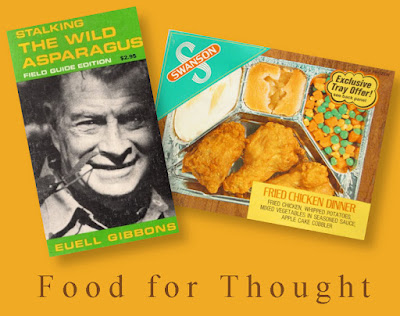Back in the 60s, when the “back-to-nature” movement was drawing its first breath, a little book came out: Stalking the Wild Asparagus. It was written by Euell Gibbons, who long advocated eating wild foods. (It's unfortunate that he appeared in a Grape-Nuts commercial nibbling on pine needles, making him the butt of many jokes.) Having foraged all his life to supplement what one gets from the local grocery store, he believed we all could benefit from many plants long forgotten by farmers. But he also believed partaking of this wild banquet provided a respite, a temporary liberation, from an increasingly-industrialized world where one could buy a complete dinner frozen in an aluminum tray.
While foraging for a topic for my blog, the phrase, “Stalking the Wild Aesthetic,” budded in my mind. I have no idea where it came from; perhaps it sprouted from a now-buried memory when, as an adolescent and voracious reader, I'd enjoyed Gibbons' books. The words “wild” and “aesthetic” certainly apply to plein air painting, but I wondered what Euell Gibbons had to do with it?
Consider his quest for a temporary liberation from an overly-industrialized world. For those of us who paint the natural landscape and not cityscapes, outdoor painting is certainly that. But it is also a respite from an increasingly-technologized world, a world flooded with easy imagery and drowning in selfies. Even so, while on the mini-vacation that plein air painting gives us, many painters post pictures of themselves working on-location. Lately, I've been trying to avoid this practice, as the act violates the delicate shelter of quiet observation I've intently built while painting. (Sure, leaving my smartphone at home would solve the problem, but I often hike to areas where one might step on a rattlesnake, run into a mountain lion or stumble off a cliff.)
That's good for the “wild” part, you say, but what about “aesthetic?” Well, how many of us go for the postcard view? Our choice is often the easy one, fed by an aesthetic we share with other plein air painters, drawing its nutrients from decades of viewing “pretty” pictures. Of course, there's nothing wrong with this, as there's a reason that kind of image appeals to us. Sometimes it's nostalgia for an era we'd like to recreate; sometimes it's an aspiration to a classic ideal; sometimes it's the desire to emulate another painter we admire. Unfortunately, this doesn't help us develop a unique and personal and—perhaps wild—aesthetic.
Over the years, Euell Gibbons was at times a carpenter and cowboy; a boat builder and beachcomber; a Communist and later, a Quaker. “I became a Quaker,” he said, “because it was the only group I could join without pretending to have beliefs that I didn't have or concealing beliefs that I did have.” His life was an expression rooted in individuality, qualities that each of us should aspire to.
Perhaps “Stalking the Wild Aesthetic” isn't such an unreasonable description of what we do when we take our easel outdoors.

